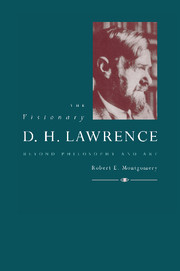Book contents
- Frontmatter
- Contents
- Acknowledgments
- 1 Introduction
- 2 Flesh, Word, and Holy Ghost: Lawrence and Schopenhauer
- 3 The passionate struggle into conscious being: Lawrence and Nietzsche
- 4 “A dry soul is best”: Lawrence and Heraclitus
- 5 The science of the soul: Lawrence and Boehme
- 6 Conclusion: Romanticism and Christianity
- Bibliography
- Index
1 - Introduction
Published online by Cambridge University Press: 08 January 2010
- Frontmatter
- Contents
- Acknowledgments
- 1 Introduction
- 2 Flesh, Word, and Holy Ghost: Lawrence and Schopenhauer
- 3 The passionate struggle into conscious being: Lawrence and Nietzsche
- 4 “A dry soul is best”: Lawrence and Heraclitus
- 5 The science of the soul: Lawrence and Boehme
- 6 Conclusion: Romanticism and Christianity
- Bibliography
- Index
Summary
THE IMAGINATION
Lawrence criticism from the start has been polarized around two conflicting, mutually exclusive views of his life and work. One view sees him as an artist whose ideas are relevant only insofar as they are embodied in a concrete work of art; the other sees him as a prophet whose real importance is his life and message. The two most influential early critics epitomize this polarity. For Middleton Murry, the essential Lawrence is not an artist at all: “ At bottom he was not concerned with art.” He was rather “the great life-adventurer of modern times,” the author of a “gospel” transcending art (153–55). In rejoinder, F. R. Leavis insisted that Lawrence is above all an artist, “a great novelist, one of the very greatest, and it is as one of the major novelists of the English tradition that he will, above all, live” (D. H. Lawrence 4). Beyond their common estimate of Lawrence's greatness, there is no point of contact between these two distinguished critics. Leavis emphasizes Lawrence's “transcendent intelligence” and champions him as a positive moral force, but his interest is in exploring the aesthetic “resources of organization in the whole” (19), and his ideal is the “wholly impersonal” (177) work of art that has been fully rounded off and separated from its creator. For Murry, the tracts and the novels alike are interesting only as evidence of the thoughts and inner life of their creator.
- Type
- Chapter
- Information
- The Visionary D. H. LawrenceBeyond Philosophy and Art, pp. 1 - 42Publisher: Cambridge University PressPrint publication year: 1994
- 1
- Cited by



